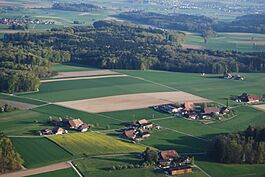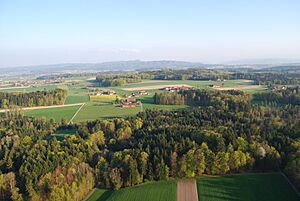Scheunen facts for kids
Quick facts for kids
Scheunen
|
||
|---|---|---|

Aerial view of Scheunen village
|
||
|
||
| Country | Switzerland | |
| Canton | Bern | |
| District | Bern-Mittelland | |
| Area | ||
| • Total | 2.2 km2 (0.8 sq mi) | |
| Elevation | 575 m (1,886 ft) | |
| Population
(Dec 2011)
|
||
| • Total | 82 | |
| • Density | 37.3/km2 (96.5/sq mi) | |
| Postal code |
3305
|
|
| Surrounded by | Bangerten, Brunnenthal (SO), Etzelkofen, Iffwil, Messen (SO), Rapperswil | |
Scheunen was once a small municipality in the Bern-Mittelland area of the canton of Bern, Switzerland. On January 1, 2014, Scheunen joined with another municipality called Münchringen. Together, they became part of the larger municipality of Jegenstorf.
Contents
History of Scheunen
Scheunen was first mentioned in old documents in the year 1226. Back then, it was known as Schunon.
Early Settlements and Villages
The oldest signs of people living in this area are ancient Hallstatt era grave mounds. These mounds are found at places called Steinholz and Junkholz. Later, during the Early Middle Ages, these same grave mounds were used again as a cemetery.
What we know today as Scheunen was actually two separate villages. These were Oberscheunen and Jegenstorf-Scheunen. They belonged to different church areas, or parishes. One was part of Jegenstorf, and the other was part of Messen-Scheunen.
Joining the Reformation and Merging Villages
After 1530, both villages joined the new Reformed church area of Messen. This was in the Canton of Solothurn. In 1795, the two villages decided to form one school district. However, they stayed politically separate until 1911. That year, a special order officially merged them into one municipality.
From 2007, the local government tasks for Scheunen were handled by the municipal clerk in Iffwil.
Changes in Government Control
Originally, both villages were under the control of the Counts of Kyburg. This was part of their local court system in Jegenstorf. When the Kyburg family ended in 1406, the city of Bern took over. Bern then placed the villages under the court at Zollikofen.
After the Act of Mediation in 1803, Scheunen became part of the Fraubrunnen district. Later, on January 1, 2010, it joined the new Bern-Mittelland administrative district.
Geography of Scheunen
Before it merged, Scheunen covered an area of about 2.2 square kilometers (0.85 square miles). A large part of this land, about 45.9%, was used for farming. Forests covered an even bigger part, about 51.4% of the area. Only a small portion, 3.2%, had buildings or roads.
Land Use and Features
Most of the built-up area was for houses and other buildings, making up 1.8%. Roads and other transport areas were 1.4%. All the forested land was covered with thick forests. For farming, 41.3% of the land was used for growing crops. The rest, 3.7%, was used as pastures for animals.
Scheunen was once the smallest municipality in the Bern canton. It is located on a high flat area called the Rapperswil plateau. The municipality included two small villages, or hamlets: Scheunen and Oberscheunen.
Scheunen's Coat of Arms
The official design of Scheunen's coat of arms is quite interesting. It shows two barns, one above the other. The background is split into two colors: gold on top and red on the bottom. The barns themselves are "counterchanged," meaning their colors switch depending on the background.
This design is a great example of canting arms. This means the picture on the coat of arms sounds like the name of the place. In German, "Scheunen" means "barns," which is exactly what you see!
Population and People
In 2011, Scheunen had a population of 82 people. About 4.9% of these people were foreign nationals living there in 2010. Over ten years, from 2000 to 2010, the population grew by 30%. This growth was mostly due to people moving into the area.
Language and Background
Almost everyone in Scheunen, as of 2000, spoke German as their main language.
In 2008, the population was almost equally split between males and females. About 49.4% were male and 50.6% were female. Most people were Swiss citizens.
Many people living in Scheunen in 2000 were born there (45.6%). Others were born in the same canton (42.1%). A few were born elsewhere in Switzerland.
Age Groups and Households
In 2010, children and teenagers (ages 0–19) made up a good portion of the population, about 28.4%. Adults (ages 20–64) were the largest group at 58%. Seniors (over 64) made up 13.6%.
In 2000, there were 24 single people and 29 married people in Scheunen. Most apartments were lived in all the time.
Population Changes Over Time
The chart below shows how the number of people living in Scheunen has changed over many years:

Economy and Jobs
In 2011, Scheunen had no unemployment, meaning everyone who wanted a job had one. In 2008, there were 33 people working in the municipality.
Main Job Sectors
- Farming: 18 people worked in the primary economic sector, which mainly involves farming. There were 7 businesses in this area.
- Manufacturing and Construction: 10 people worked in the secondary sector. This included manufacturing and construction. There were 3 businesses here.
- Services: 5 people worked in the tertiary sector, which includes services like technical jobs. There was 1 business in this sector.
Out of all the working people, about 45.7% were women.
Commuting and Travel
In 2000, 23 workers traveled outside of Scheunen for their jobs. About 8.6% of working people used public transportation to get to work. A much larger number, 54.3%, used a private car.
Religion in Scheunen
According to the 2000 census, most people in Scheunen were part of the Swiss Reformed Church. About 94.7% of the population belonged to this church. There was also one person who was Roman Catholic.
Education in Scheunen
Many adults in Scheunen had a good education. About 31.6% of the population had finished non-mandatory upper secondary education. This is like high school. Another 17.5% had gone on to higher education, such as university.
During the 2010-2011 school year, no students were attending school directly in Scheunen. However, in 2000, 6 students from Scheunen went to schools outside the municipality.
See also
 In Spanish: Scheunen para niños
In Spanish: Scheunen para niños





